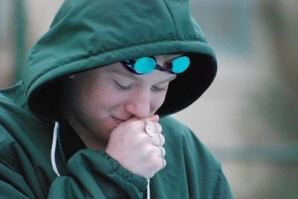Beyond the north end zone of Notre Dame Stadium, high above the scoreboard and all of the action that takes place on the field below, stands the south wall of the Hesburgh library. Adorned upon that wall is the “World of Life” mural, known by countless college football fans as “Touchdown Jesus.”The mural epitomizes the connection between athletics and religion. “Touchdown Jesus” reminds athletes, students and regular fans alike that whether for positive or negative, motivation or restriction, religion appears to be ever present in the athletic world.
The foundations of athletic excellence can be drawn from a variety of sources. Although controversial, religion is consistently cited by athletes as source of motivation and guidance that teaches discipline and the other tools necessary for success as an athlete.
On Friday, Sept. 18, 2,254 miles away from Notre Dame, the Palo Alto High School football team knelt in a circle and recited a prayer before taking on the Archbishop Mitty Monarchs in Paly’s second game of the season. No fan would be surprised if they saw the Monarchs praying before the game, seeing as Mitty is a Catholic school and part of the West Catholic Athletic League. However, it may have appeared more unusual for Paly, a public school with no religious affiliation, to hold a pregame prayer.
Onlookers may have wondered what kind of role religion plays in a high school football game. It was not clear why this public school team chose to look to God for guidance. Nonetheless, the entire team knelt together, asking for safety and the ability to play to their fullest potential. This team, composed of diverse religious views, prayed together under a common set of ideals.
On Sept. 18, different players held the prayer in different regards. Maybe some players took the words to heart. Maybe some saw the prayer as just another part of pregame warmups. Although religion may not be as prevalent on high school fields as on the overgrown grass at Notre Dame stadium, the fact remains that religion plays some kind of role on many athletic teams, regardless of the school.
Some athletes choose to ignore religion, and some choose to accept it. Some believe that a commitment to religion can hold an athlete back and create conflict. Others believe religion can provide motivation and guidance in pursuit of goals.
Paly varsity lacrosse player Sam Herzog (’10) chooses to play an active role in her Jewish community. Although she follows the guidelines of reform Judaism, which essentially allows her to decide how big of a role she wants religion to play in her life, Herzog holds her involvement with her religious community as a high priority. Despite her sports schedule, Herzog makes countless sacrifices in order to uphold her religious commitment. In regard to her athletic career, Herzog finds that certain concepts tie religion and sports together, for instance, the idea of a strong community.
“The most important thing that applies for me is ‘kehillah kedosha,’ which literally means ‘sacred community,'” Herzog said. “It’s the idea of creating a holy community, which means, to me, a safe, close-knit and supportive community, and this definitely applies to how I feel about the lacrosse team.”
Throughout her athletic career, as well as in her day to day life, Herzog finds that religion affects the way people carry themselves both on and off the field.
“The [religious] values I was brought up with govern how I act in everyday life, including lacrosse for me,” Herzog said. “Because religion plays a big role in the way people think, it inevitably changes the way people play.”
Herzog also believes that religious influences in sports can raise conflicts.
“People aren’t really aware of the commitment conservative and orthodox Jews have to their religion,” Herzog said. “They cannot really commit to sports because they have to miss Friday night and Saturday practices for Shabbat.”
Even on the professional level, players must choose between commitment to faith and commitment to their sport, team and fans.
Sandy Koufax, a hall of fame pitcher for the Brooklyn, and later, Los Angeles Dodgers from 1955-1966, refused to pitch in game one of the 1965 World Series because the game fell on Yom Kippur. Instead of pitching, Koufax went to a nearby synagogue in accordance to the customs of Yom Kippur. Dodger great Don Drysdale took the mound in Koufax’s place. Newspapers covering the game reported that when manager Walter Alston took Drysdale out of the game after a decidedly lackluster two-inning performance, Drysdale sarcastically suggested to Alston, “I bet right now you wish I was Jewish, too.” The Dodgers lost 8-2 and Koufax’s decision fell subject to a great deal of skepticism from the media and fans.

Like Herzog, Paly swimmer DJ Fotsch (’11) grew up with sports and religion as two overlapping elements. Fotsch was raised in a Catholic family and attended a Catholic school until eighth grade. All his life, religion has been a constant presence in his life. While he feels that religion guides him in everyday life, Fotsch feels an especially strong connection in swimming.
“I feel that God gave me the talent of being a good swimmer, and I am doing my best to thank him by trying hard to improve,” Fotsch said.
Fotsch plans to maintain this connection between swimming and religion as he continues to pursue his goals. He hopes to swim competitively at the University of Notre Dame.
Beyond his own experience, Fotsch feels religion is generally seen as a positive influence in the sports world.
“I feel people view [religion] as a positive thing because it usually makes players behave better,” Fotsch said. “[Religion] keeps them from getting into too much trouble.”
Few athletes are better at staying out of trouble than Arizona Cardinals quarterback Kurt Warner. USA Today recently recognized Warner, who is a devout Christian, with the Most Caring Athlete award for 2009. In a recent Sports Illustrated poll of 296 NFL players, Warner was voted the best role model in the NFL. Warner and his wife Brenda run a Christian foundation called First Things First. Through this program, Warner raises money for charities and hospitals all over America while emphasizing the importance of placing faith, whether it is in religion, family or ability, above all else.
Throughout his football career, Warner endured countless highs and lows, but he attributes his ultimate success to his faith in God. Many athletes suffer through failures, but great athletes turn failures into motivation. Throughout his career, Warner has been able to channel his failures and frustration through his persistent faith in God.
After multiple NFL teams turned Warner down, he took a job as a bag boy at a Hy-Vee grocery store in Cedar Falls, Iowa near his hometown of Burlington. While working for minimum wage at the grocery store, Warner continued his football career while playing in the AFL for the Iowa Barnstormers and eventually in NFL Europe with the Amsterdam Admirals. After short stints in both leagues, the St. Louis Rams signed Warner in 1998.
After starter Trent Green suffered a torn ACL in a preseason game in 1999, Warner promptly stepped in and lead the Rams to a Super Bowl victory over the Tennessee Titans. During that season, Warner became the sixth player ever to win MVP awards for both the regular season and the Super Bowl.
But, after receiving another MVP award in 2001, Warner began to struggle. After a lackluster 2002 season, Warner began the 2003 season by fumbling six times in the Ram’s season opener. Warner warmed the bench and drifted into obscurity after the Rams dealt him to the Giants the following year. Warner was later traded to the Cardinals where, after competing for the starting position for four years, he lead Arizona to a Super Bowl appearance in the 2008 season. Despite Arizona’s loss, Warner found a way to overcome the challenges placed before him. Today, Warner presents himself as living proof of what commitment and faith can bring to an individual and those around him.
In postgame interviews, Warner always thanks God and Jesus for guidance. While many people find this humble gesture refreshing, others see his allusion to religion as unnecessary.
Paly varsity tennis player and Mormon Drew Pearson (’10) views the idea that God guides athletes as unrealistic. While Pearson sees religion in sports in a positive light, he believes that, in general, the sports world would disagree with him.
“When people hear a pro say they were guided by God or something they just get turned off from it and find it ridiculous,” Pearson said.
Pearson believes that God may “watch over” athletes, but beyond that, the individuals determine the end result.
Paly basketball player Nathan Bills (’12) believes that, when compared to an athlete’s skill level and work ethic, religion plays a negligible role in an athlete’s success.
Bills does not look to religion for motivation or guidance while playing and he chooses not to worship any God. Instead, Bills relies on his own skill and confidence to compete to the best of his ability.”I don’t think religion makes a difference in the way athletes play their sports,” Bills said. “The success of an athlete depends on their work ethic and skills, not their religious beliefs.”
While Bills recognizes that many athletes demonstrate their faith while playing, like when athletes point to the sky after making a big play, he feels that faith neither assists nor restricts an athlete in their pursuits of their goals.
Despite his skepticism about the extent of God’s involvement with individual athletes, Pearson feels the effects of religion in his everyday life, as well as in his athletic pursuits. However, unlike Fotsch, Pearson does not have religion pushing him to play at the next level. His Mormon commitment does not allow him to play on the Sabbath, which for Mormons is Sunday. Unfortunately for Pearson, the bulk of tennis tournaments are on Sundays, which leaves him no choice but to sit out.
“I have not participated in any tournaments, so I have not been able to get a good ranking,” Pearson said. “Getting recruited to college is basically impossible.”
While Pearson faces this obstacle, he does not think it affects the way he plays the game. In fact, he believes his faith works to his advantage by giving him a broader perspective.
“While I am playing, my faith helps the way I feel,” Pearson said. “I try to remember that this one match or game is not that important when compared to the big picture.”
This mindset allows Pearson to relax and play to his fullest potential without worrying as much about the end result.
Like Pearson, Paly basketball player Nehika Miglani (’10), who is Hindu, feels that faith is vital in maintaining a competitive mindset.
“Religion affects a person’s mentality,” Miglani said. “If athletes can find their inner strength and get past their mental block of how tired they think they are, they can push through and go harder.”
Miglani also feels that in order for an athlete to contribute to her team, she has to maintain a positive attitude, regardless of the situation.
“The gods I pray to teach that one must always keep positive energy in bad situations,” Miglani said. “When my team is losing a game or just playing horribly, I make it a point to make sure the team does not get an attitude or give up.”
Focus and strong mentality play vital roles in the success of athletes in multiple sports of all levels.
Paly cross-country and track standout Philip MacQuitty (’10) agrees that mental toughness is the most important strength for a long distance runner.
“[In training], you are essentially giving yourself the opportunity to take more pain for a longer period of time,” MacQuitty said. “That is all mental toughness. For the second half of the race, it is in your head whether you do well or not.”
While coordination and raw athleticism are not as essential to running long distance as they are to playing other sports, rarely do athletes face a greater mental challenge than running a marathon.
Due to cross-country’s demand for mental toughness and endurance, it may not be a coincidence that many of the sport’s top competitors are devoutly religious. A runner’s faith may give them more strength when their endurance is at its end.
In recent history, African runners, many of whom are devout Christians, have been dominant. Since 1988, only two non-Africans have won the Boston Marathon. Scientists cite the high altitude of the Rift Valley and genetics as the main contributors to the African’s dominance, but faith in religion is rarely brought up as a reason for the runners’ success.
Twenty-seven year old American runner Ryan Hall, a devout Christian, is one of the few non-Africans considered when the topic of the best runners in the world arises. At the London Marathon on Apr. 13, 2008, Hall ran in his third marathon and finished fifth with a time of two hours, six minutes, 17 seconds, the second fastest time ever by an American. In April of this year, Hall came in third at the Boston Marathon, posting a time of two hours, nine minutes, 40 seconds. Hall finished behind Kenyan Daniel Rono and Ethiopian Deriba Merga.
Although he did not grow up in the Rift Valley climate like many of the African runners, Hall does share a common faith. In interviews, he frequently attributes his success and mentality to his faith in God. Hall believes that God intended for people to work hard and that running is a way for him to fulfill God’s will.
Hall may draw his beliefs from biblical passages, such as Paul’s letter to the Corinthians 9:24-25, which reads:
“Do you not know that runners in the stadium all run in the race, but only one wins the prize? Run so as to win. Every athlete exercises discipline in every way. They do it to win a perishable crown, but we an imperishable one.”
The struggle of a long distance runner may even be comparable to Jesus’ forced march with the cross on his back. Jesus’ suffering may give a Christian runner the faith and determination that allows him or her to battle through pain and put forth their greatest effort.
For individual athletes, religious commitment is often of their own volition, but when religion is forced upon a group, athletes can be restricted. Not all athletes have the freedom to choose whether or not they want religion to be involved in their athletic careers. Such was the case in Afghanistan.
Under the rule of the Taliban, women were denied the right to appear in public unless wearing full-body clothing. They could not be subject to any kind of education, much less participate in any kind of sport. With women out of the education system, the Taliban used male teachers to spread radical ideas emphasizing the restriction of basic freedoms, particularly for women. The Taliban ran madrasas (schools) that taught radical views derived, frequently incorrectly, from their religious guidelines.
The Taliban derived its laws from Sharia, the Islamic religious law. The Taliban’s interpretation of Sharia became progressively more radical as their power grew. By the time the Taliban gained power in Afghanistan in 1996, womens’ participation in sports was unacceptable and severely punished.
At this time, women in Afghanistan had no choice but to sacrifice all athletic pursuits and abide to the Taliban’s restrictions. The issue was far beyond the idea of religion providing guidance or motivation in sports. Instead of being a positive influence in athletics, the government’s interpretation of religion denied women the right to compete. Ever since the US and coalition forces overthrew the Taliban in 2001, womens’ sports have come back into prominence. Without the restrictions of a radical religious government, female athletes now have the right to compete.
In the 2004 Olympics in Athens, then 17-year-old Afghan sprinter Robina Muqimyar took advantage of her newfound rights. Muqimyar became one of the first two women ever to represent Afghanistan in the Olympic games. Wearing a t-shirt, long pants and a headscarf, Muqimyar clocked a time of 14.14 seconds in the 100 meters. Although she finished three seconds behind Jamaica’s Veronica Campbell, the significance of Muqimyar’s achievement for Afghanistan is immeasurable. Since Afghanistan is almost completely devoid of training facilities, it was difficult for Muqimyar to prepare. Prior to the games, Muqimyar trained in stadiums formerly used by the Taliban as execution sites. Muqimyar’s achievement opened up the door for female Afghan athletes, who now, free from the rule of their past radical religious government, have the freedom to compete.
Many great athletes believe they succeed in today’s athletic world because they have faith in something greater than themselves. However, in other circumstances, such as those faced by Robina Muqimyar, there is no greater restriction than the influence of faith. But, even while Nathan Bills watches a favorite athlete point to the sky, thanking God for the ability to make a play, the presence of religion is seemingly ubiquitous. So, whether the player who glides into the north end zone at Notre Dame stadium points to the sky or not, “Touchdown Jesus”, with outstretched arms, will always be there to take it in.






